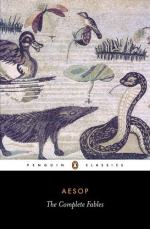|
This section contains 4,287 words (approx. 15 pages at 300 words per page) |

|
SOURCE: "Reconstruction and Deconstruction: La Fontaine, Aesop and the Eighteenth-Century French Fabulist," in Papers on French Seventeenth Century Literature, No. 11, Summer 1979, pp. 29-46.
In the following essay, Runte compares the Aesopic fable with the work of French writer Jean de la Fontaine, identifying this distinction: while Aesopic fables treat the reader as a student to be instructed, La Fontaine's fables in verse treat the reader as a coparticipant in interpreting the fable's meaning.
"Une ample comedie a cent actes divers," La Fontaine thus characterized his collection of fables.1 Critics have not been remiss in exploring the dramatic qualities of these "scenes parfaites pour les caracteres et le dialogue."2 Dialogue has been explored primarily on the level of the plot line and in terms of the characters created by the fabulist: "Le Fabuliste fait de ses animaux ce qu'un Dramatique habile fait de ses Acteurs."3 However, a second level...
|
This section contains 4,287 words (approx. 15 pages at 300 words per page) |

|


